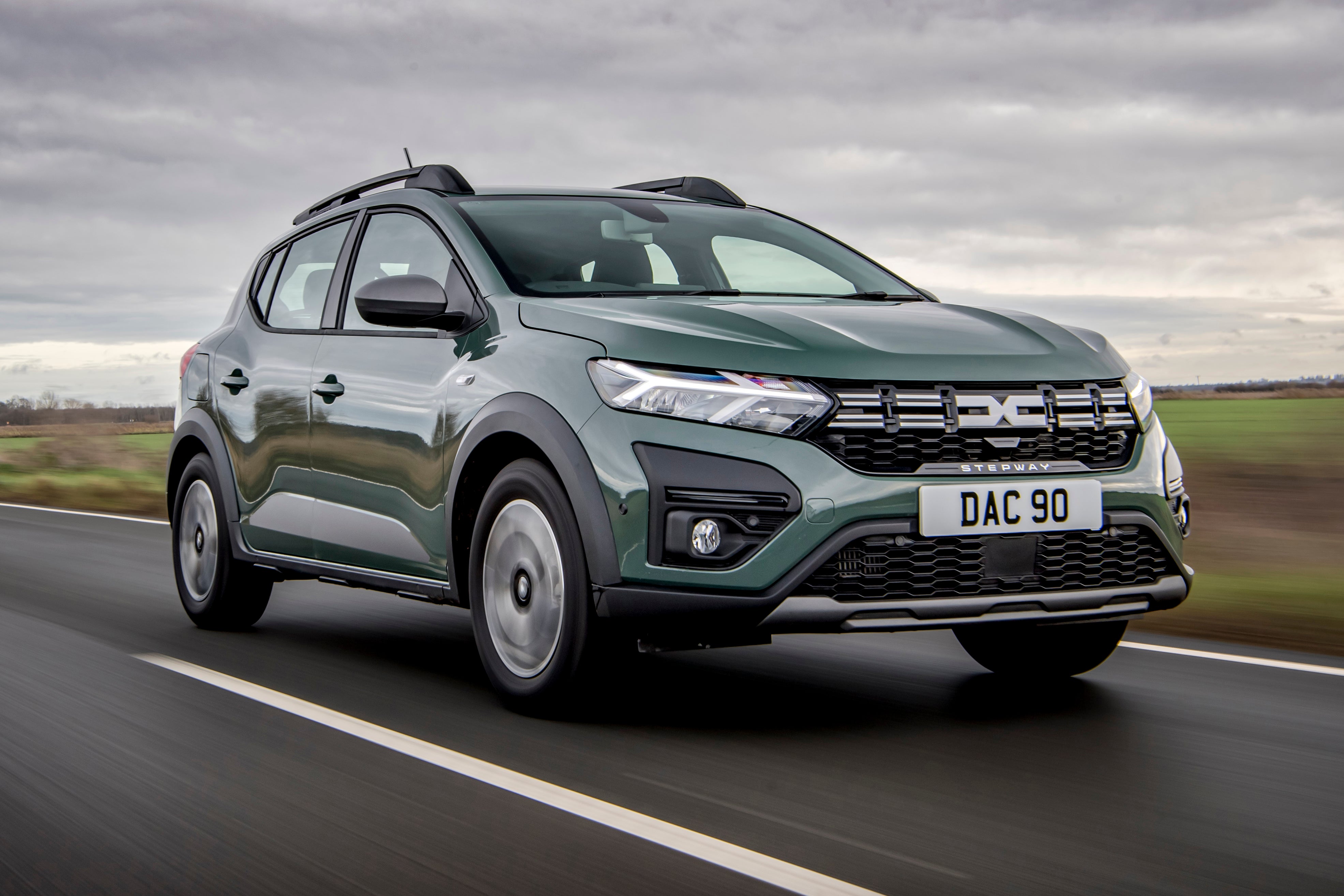Dacia Sandero Stepway Review 2025: Price, specs & boot space
Written by Lawrence Allan
Quick overview
Pros
- Still cheap to buy and run
- Roomier than you'd expect inside
- Comfortable and easy to drive
Cons
- Less refined and fun to drive than pricier small cars
- Not the absolute bargain it once was
- Regular Sandero is about 10% cheaper
Overall verdict on the Dacia Sandero Stepway
"How do you make one of Britain's cheapest new cars - the Dacia Sandero - more desirable? By turning it into Britain's cheapest SUV. Sort of. Read on to find out what we think of it in this 2024 Dacia Sandero Stepway review."
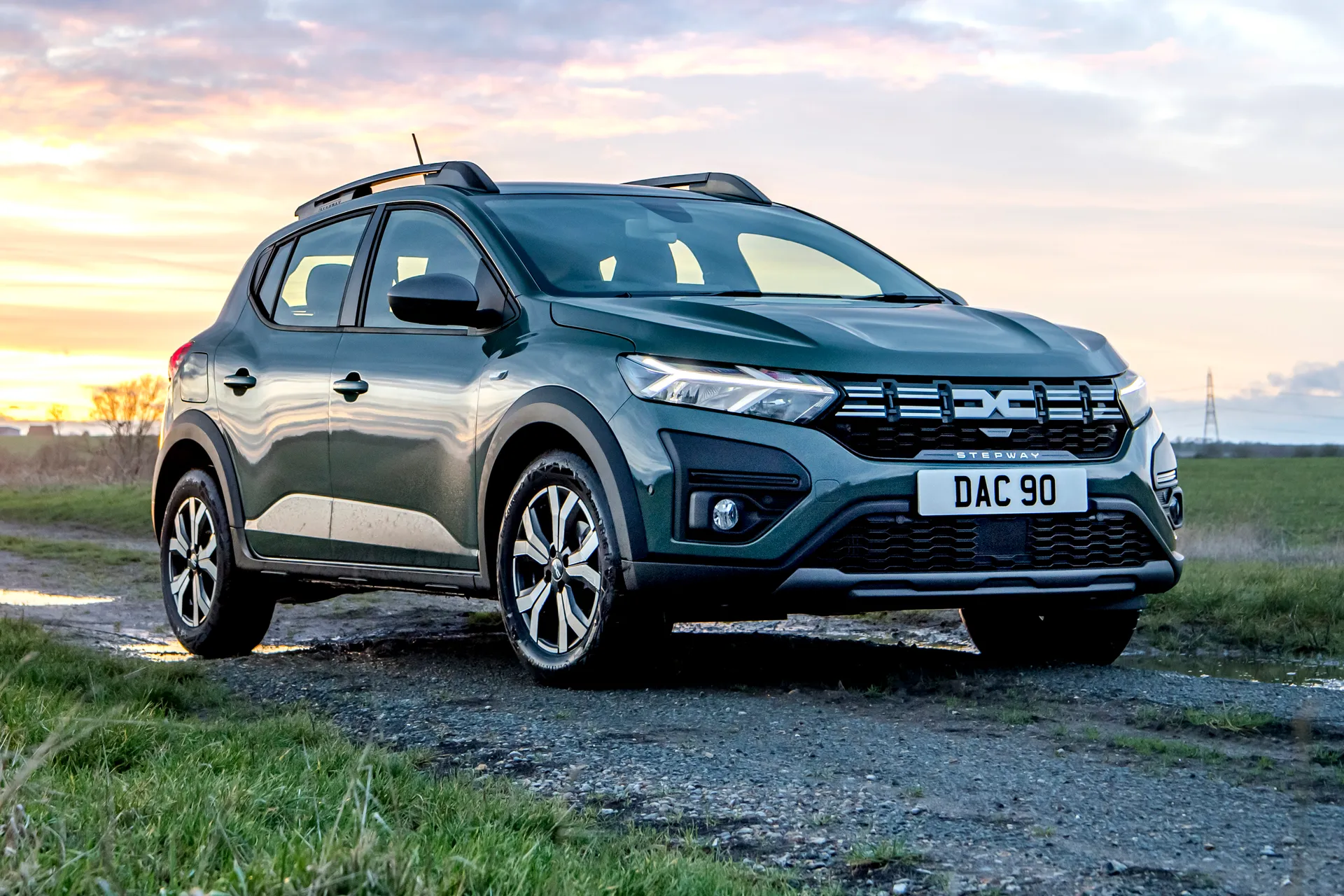
Alright, so the Dacia Sandero Stepway probably stretches the definition of 'SUV' a little too far, even when the term now takes into account a range of jacked-up hatchbacks that are loosely described as small SUVs these days. But it certainly has some of that oh-so-desirable rugged appearance.
Key upgrades over the regular Dacia Sandero include roof rails, plastic wheelarch extensions, faux metal bumper skidplates, a 40mm raised ride and a few other styling tweaks. Other than that, it's the same plucky little Sandero underneath.
That means the Sandero Stepway is still front-wheel drive, with no fancy off-road gadgetry such as locking differentials, selectable four-wheel drive and terrain modes. So no, this isn't going to chase a Land Rover (or even a Fiat Panda 4x4) across the country's gnarliest byways. But it will negotiate the urban jungle, mount a few kerbs and get down your aunt's potholed rural driveway. Which, if we're being honest, is all the vast majority of people need an SUV to do.
If you really need something more rugged and capable, there's always the superb Dacia Duster for a few grand more. And on the subject of price, plumping for the Dacia Sandero Stepway over the regular Sandero will set you back another £1200. With our sensible hat on we say it isn't really worth the extra, but we can understand the appeal of the Stepway's added ground clearance and more robust body.
Being based on the regular Sandero means it too is no longer available in the headline-grabbing base trim levels. Only a few years ago, both models started at well below £10,000, but Dacia has decided not to bother with the bog basic trim levels because most buyers didn't either. Still, it makes a Ford Fiesta Active look positively expensive.
The removal of those base trims means the entry point Stepway is no longer as well-appointed as a medieval prison. Even the cheapest Dacia Sandero Stepway Essential gets kit such as DAB radio, Bluetooth, air-con, cruise control and even LED headlamps, while sat-nav, keyless entry and a reversing camera come further up the range. Sure, the interior trim isn't exactly luxurious, but it doesn't feel like it would fall off after three speed bumps, either.
It's spacious, too. The Dacia Sandero Stepway is no bigger than the regular car, but it's still one of the biggest superminis on sale, even on nodding terms with the Honda Jazz. Four six-footers could tolerate long journeys, there's tonnes of headroom, and the boot is pretty impressive, too.
Of course your biggest obstacle on longer journeys is how the Sandero Stepway drives. The entry-level TCe 90 turbo is punchy enough for most needs. Refinement isn't brilliant, but neither is it ear-piercingly noisy. There's also a slightly more powerful TCe 100 Bi-Fuel model that can also run on LPG, although good luck finding a filling station that sells it. A slightly-more-powerful-still TCe 110 version completes the range.
Ride comfort is better than you might expect thanks to the Dacia Sandero Stepway's soft suspension, which deals with craggy surfaces pretty well. That does mean handling is a long way off the best small car rivals, with plenty of body lean, gloopy steering and an unsettled feel on country roads. It does the job well enough, though, and is a doddle to drive around town.
With good fuel economy, plus low insurance and tax costs, the Dacia Sandero Stepway is already affordable before you consider it's about half the price of the best small SUVs. It might not be sophisticated, but basic transport has never been better.
Looking for a used car for sale? We've got 100s of Dacia Approved Used Cars for Sale for you to choose from, including a wide range of Dacia Sandero Stepway models for sale. If you're looking for the older version, you need our used Dacia Sandero Stepway (2013-2021) review.
Is the Dacia Sandero Stepway right for you?
You'll buy a Dacia Sandero primarily because you want cheap transport, but a city car is too small. Even though it's no longer half the price of rivals, it's still several thousand pounds less than even the cheapest Skoda Fabia in 2024.
The same key selling point applies to the Sandero Stepway, but you'd buy that because you also want something more rugged and slightly more practical. The roof rails make it easier to carry bikes or roof boxes, the raised ride height helps negotiate farm tracks and the like, and the plastic body inserts mean you're less bothered by car park dings.
What’s the best Dacia Sandero Stepway model/engine to choose?
There are only three engines to choose from, and all are pretty similar. The vast majority will opt for the Dacia Sandero TCe 90, which is available with a manual or automatic gearbox. It's powerful enough to keep up with the flow of traffic thanks to a turbocharger, but it's not the quietest or punchiest turbo three-cylinder engine around. We'd go for the manual, as the automatic is noticeably slower and thirstier. The other two engines only deliver 10PS and 20PS more, respectively.
In terms of trim levels, Essential spec isn't too sparse these days, but we'd be tempted to step up to Expression (previously Comfort) trim for the 8.0-inch touchscreen with smartphone connectivity.
What other cars are similar to the Dacia Sandero Stepway?
If you're looking for a small SUV for the same price as the Dacia Sandero Stepway, you'll be looking for a used model with a few years and tens of thousands of miles on the clock.
For the same size and type of car, you'd be looking at a Honda Jazz Crosstar or Ford Fiesta Active, but they command a premium of several thousand pounds when new. There is the more rugged Fiat Panda Cross, but that's smaller and an older design, while don't discount the Suzuki Ignis, either, as an SUV-inspired small car.
Comfort and design: Dacia Sandero Stepway interior
"The Dacia Sandero Stepway won't blow you away with striking design and robust build quality, but everything has to be taken in the context of its extremely low price. Bare that in mind, and you'll find very little to fault. The raised ride height makes it feel more SUV-like."
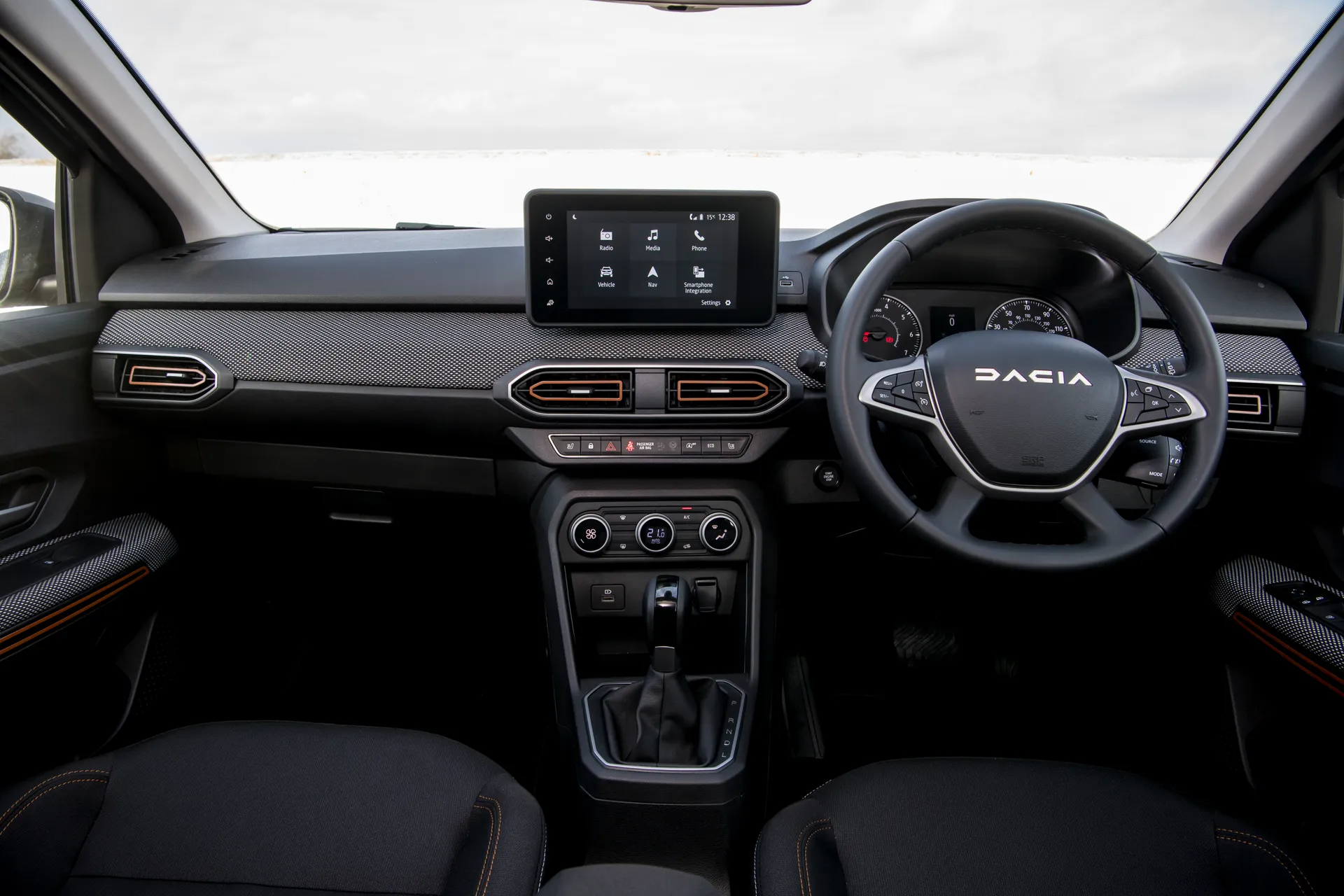
If you're stepping into a Dacia Sandero Stepway expecting cool tech and a Volkswagen Polo-like feeling of poshness, then you obviously haven't looked at the price. It's never going to wow you unless you're stepping out of a car built two decades ago. That shouldn't surprise you given how much car you're getting for such little outlay.
Compared to the old Sandero Stepway, which was pretty flimsy and depressing inside, the newer model is a big improvement. The design is pretty smart and modern, nothing feels desperately cheap and it's significantly easier to get comfortable behind the wheel.
You get such decadence as a height-adjustable driver's seat, a steering wheel that adjusts for reach and rake, and - on top models - even a centre armrest. Even tall drivers won't struggle for space, either, while that raised ride height means that (if you get the seat jacked up) you might be fooled into thinking you're driving a full-on SUV. Forward visibility is very good, and the rear isn't too bad, either, although the mid-spec models with parking sensors are worth stepping up to.
We also like that Dacia thinks of ergonomics even at this price point. The air-con controls are simple separate knobs on their own stack, and even models with the central touchscreen get a handy smartphone holder on the dash. Sure, the fiddly media control stalk on the wheel isn't great, and the headlight level adjustment that's nearly in the footwell is odd, but these are minor gripes.
Quality and finish
While the Sandero Stepway's dashboard looks perfectly acceptable from a distance, closer examination reveals clearly where Dacia has been saving money.
You'll struggle to find much in the way of soft-touch trim in the entry-level Dacia Sandero Stepway, which is mostly a sea of unremitting black plastic. Mid-spec models and above get some fabric on the dashboard and door armrests, while Journey trim gets some body-colour trim elements.
Don't expect anything like ambient lighting or Alcantara (a leather steering wheel is as posh as it gets). The doors close with a hollow clang, while the glovebox flops open and is stopped from falling off with a fabric cord. But really, what do you expect with the cost savings Dacia had to make at this price point?
Crucially, there aren't really any sharp edges, all the trim seems to line up and none of the switchgear feels like it will fall off and break with minimal effort. Certainly, compared to cheap cars a decade or two ago, standards have come on, and we suspect it'll provide years of faithful service.
Infotainment: Touchscreen, USB, nav and stereo in the Dacia Sandero Stepway
The Dacia Sandero Stepway Essential doesn't get an infotainment system as such. Where the screen usually is there's a small cubby with a lid instead. Happily, Dacia hasn't plumbed in some miserable dot matrix screen for the radio: instead you can link your smartphone to the car's audio system and use that display instead.
It's nice to see DAB radio and Bluetooth connectivity in the base model: it used to be that the cheapest Sanderos had no stereo at all. Sure, Essential trim only gets two speakers in the front, but it's better than listening to the sound of your passengers humming.
The Sandero Stepway Comfort comes with an 8.0-inch touchscreen that is big enough to be very usable, and while its graphics aren't crisp, they are colourful. All the main functions are accessed via clear icons on the main menu, although the screen doesn't recognise smartphone gesture controls like pinch and swipe. This uprated system also adds a couple more speakers, although we wouldn't praise the sound quality much.
The best thing about the upgraded stereo is that it features Apple CarPlay and Android Auto smartphone mirroring so you can use the apps on your phone – like Spotify and Google Maps – on the car's big screen. It's done via an app on your smartphone and you get a dash-mounted holder that gives you somewhere to put it, along with its own dedicated USB-C plug on the top of the dashboard.
Space and practicality: Dacia Sandero Stepway boot space
In terms of exterior dimensions, the Dacia Sandero Stepway measures 4099mm long, 2007mm wide (including mirrors) and 1587mm tall. That makes it 87mm taller than the regular Sandero on account of the raised ride height and roof rails, but otherwise, it's identical.
It's considerably larger in every dimension than similarly priced city cars, which is reflected when you get inside. Even bulky or lanky front passengers won't be complaining about head- or leg space, and the cabin is wide enough that they won't be banging elbows, either.
Similarly, climbing in the back is a pleasant surprise. Forget city cars, the Sandero Stepway is roomier than a number of best-selling superminis. Only a Honda Jazz or Skoda Fabia can really beat it for legroom, while even if you're over six-foot and wear a top hat, you shouldn't have a complaint about headroom. Three adults in the back is possible for short journeys, too.
Storage is okay but not amazing. The front door bins are a decent size but the rear ones are pretty tiny, while that flimsy glovebox is useful enough. There's a couple of cupholders, too, but the centre armrest (optional on all but top trims) obstructs one of them and doesn't have any cubby inside it. There is a pair of USB charging ports up front, plus a 12-volt socket, and even a shopping hook in the passenger footwell, however.
The Dacia Sandero Stepway's boot capacity is 328 litres. That number may mean nothing to you, but in plain English it's one of the largest boots in terms of capacity in its class. There's a bit of a lip to lug big items over, but you can get an adjustable boot floor, which some pricier rivals don't bother with, plus some hooks for carrying shopping bags.
The seats only fold in a 60/40 split, but that's the same with the vast majority of small cars. They don't do anything exciting, like slide or flip up, but again that'll hardly come as a shock given the price. It's not the most lavishly trimmed boot, with exposed metal and thin carpet, and the parcel shelf is a bit flimsy, but you're not putting your mother-in-law in there are you?
It's worth noting that you can get an optional space-saver spare wheel in every version except the Bi-Fuel, which uses that space to fit the LPG tank in.
Handling and ride quality: What is the Dacia Sandero Stepway like to drive?
"Don't expect excitement or sophistication from the Dacia Sandero's driving experience, and you should be pleasantly surprised. It's fuss-free, easy and comfortable on the road."
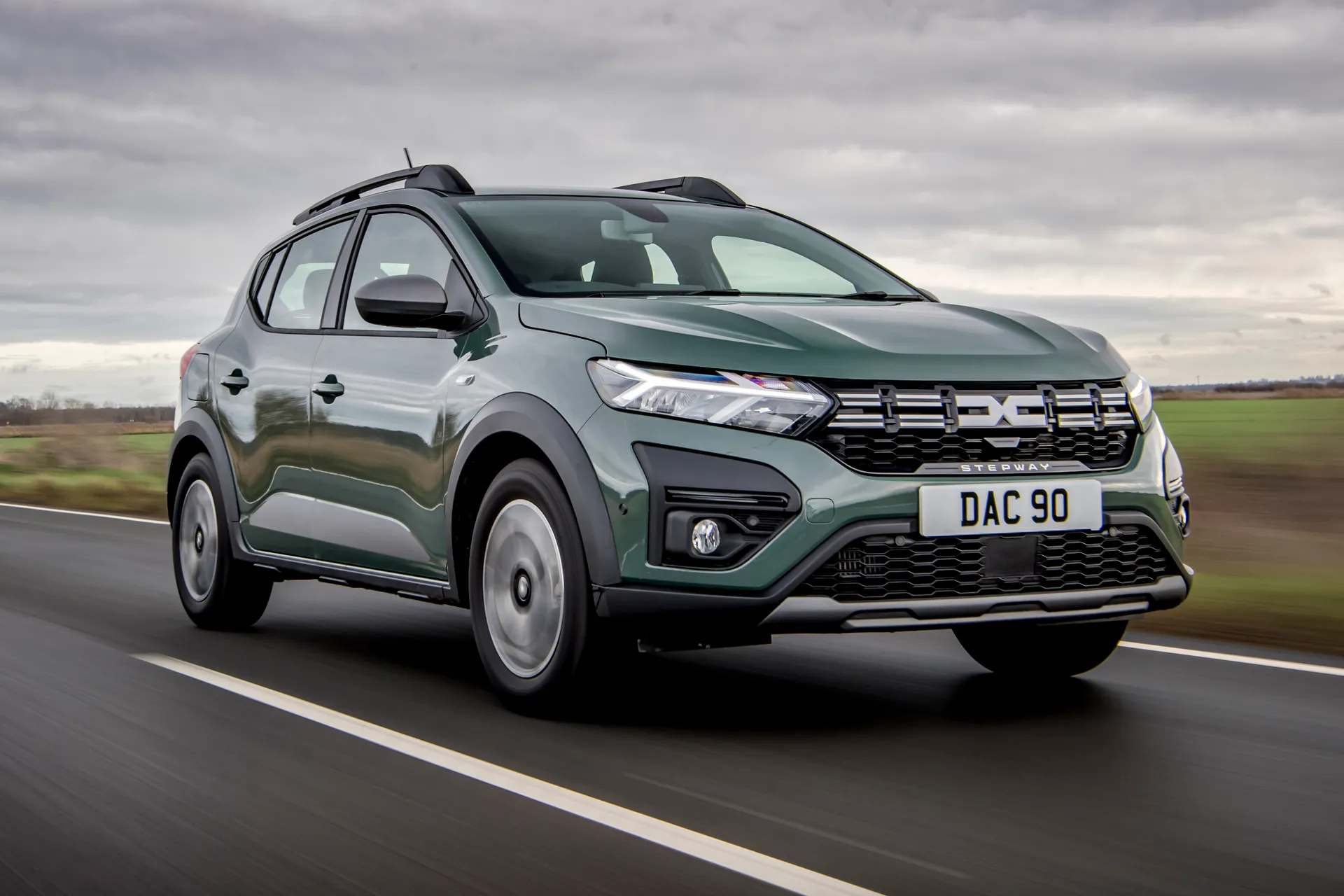
The standard Dacia Sandero is already a pretty comfortable car, with soft suspension designed to deal with poorly-surfaced Romanian roads (Dacia is a Romanian company, if you didn't know).
The Sandero Stepway has 40mm added to its ride height, so it feels a little softer still than the regular car. That makes it brilliant around town because potholes are well-isolated and speed humps don't trouble it one bit. It's also good for rough country lanes and cruising on motorways, but when you start upping the pace, the Sandero's limitations are evident.
It won't surprise you to learn that this is not a car you relish chucking into bends. Certainly it's nowhere near as agile or tied down as a Fiesta or SEAT Ibiza, with lots more body lean, not as much grip and steering that feels vague and gloopy, almost like the tyres aren't pumped up properly.
Fundamentally it's fine, and certainly not unsafe, but take an undulating country road at speed and your passengers might start feeling queasy. At least the brake pedal is firm. However, once you're cruising on a motorway that slow steering has an upside because it's less edgy and darty, while the standard-fit cruise control takes the strain off your feet on longer trips.
You can also forget about self-parking or any of that malarkey, although you do get parking sensors and a camera on higher trims. Even without them, you'll not find many cars that are easier to park than the Sandero Stepway. It offers good visibility out of all four corners and controlling the car at slower speeds is easy once you get used to the springy clutch pedal.
What engines and gearboxes are available in the Dacia Sandero Stepway?
While the cheapest Dacia Sandero was available with a non-turbocharged engine (dubbed SCe 65), this was dropped quickly due to slow sales. So the Stepway, as with the regular car, gets a handful of turbocharged three-cylinder petrol engines to choose from.
None of them offer blistering performance despite that turbocharger. The most popular Dacia Sandero Stepway TCe 90 puts out (you guessed it) 90PS, and nearly double the torque that old non-turbo motor made. It's mated to either a six-speed manual gearbox or a CVT automatic. We've not tried the latter, however.
Don't be put off by a 0-62mph time of twelve seconds sounding pretty leisurely. That turbo means that you don't need to rev it until your ears bleed just to keep up with traffic, which it does so fairly effortlessly. You'll notice when you're carrying a car-load of passengers and luggage, but in most scenarios it's quick enough for most people's needs.
What it isn't is fun. Turbo three-cylinder petrols from Ford and VW feel gutsy in the mid-range, are quite willing to rev and sound pretty fruity in the process. The TCe 90 engine isn't bad, but throttle response isn't brilliant, it doesn't sound particularly nice and there's no real point revving it past 5000rpm. Still, it cruises well thanks to the six-speed gearbox.
While we've not tried the CVT automatic, bear in mind that it's about two seconds slower from 0-62mph, and is likely to be unpleasantly loud when you ask for full performance.
Next up in the engine range is the Dacia Sandero Stepway TCe 100 Bi-Fuel. As the name suggests this has a bit more power, but the Bi-Fuel element refers to it being able to run on both petrol and LPG (liquid petroleum gas). LPG is less than half the price of regular unleaded fuel, which is great, but the number of filling stations that actually stock LPG has dwindled rapidly in the last few years.
At the top of the engine range sits the TCe 110, which was released later in the car's life and ekes out a fraction more power with - you guessed it again - 110PS. We haven't tried it, but its 0-62mph time of 10.0 seconds hints at a tad more urgency.
Refinement and noise levels
While the Dacia Sandero Stepway is certainly quieter than a small car from 20 years ago, it doesn't isolate you from wind- and road noise as well as the best small cars.
It helps that you can't get big wheels and low-profile tyres, so road noise isn't too intrusive, but it isn't as quiet as a VW Polo. Wind noise is noticeable, too, and you can tell that Dacia skimped on sound insulation given how hollow-feeling the doors are.
The TCe turbocharged engines aren't too loud, but there's a bit more engine vibration than the class best, and the engine note you do hear isn't a particularly pleasant one.
Safety equipment: How safe is the Dacia Sandero Stepway?
The Dacia Sandero Stepway received a disappointing two stars out of five from safety body Euro NCAP. That might write the car off for you immediately (figuratively, rather than literally), but before you click away, let us explain in more detail.
As it was assessed under the latest and toughest test requirements it's actually no less safe (perhaps even more safe) than a small car from about five years ago. If you look at the crash protection scores for adult and child occupants they're actually pretty good: barely any worse than the safest small cars in fact.
Where the Sandero models were marked down is in vulnerable road user protection and safety assists. This is because, as a budget model, Dacia skimps on some of the more advanced safety features you get on pricier alternatives.
You still get a multitude of airbags, ISOFIX points for the safe mounting of child seats and seatbelt pre-tensioners, plus a function that automatically calls the emergency services in the event of a crash. You also get automatic emergency braking, but it's a basic system that doesn't detect pedestrians or cyclists. You also don't get lane keeping assistance, even as an option, which caused Euro NCAP to mark it down.
MPG and fuel costs: What does a Dacia Sandero Stepway cost to run?
"The Dacia Sandero Stepway is slightly less fuel efficient than the regular hatch, but it's still cheap to insure and tax."
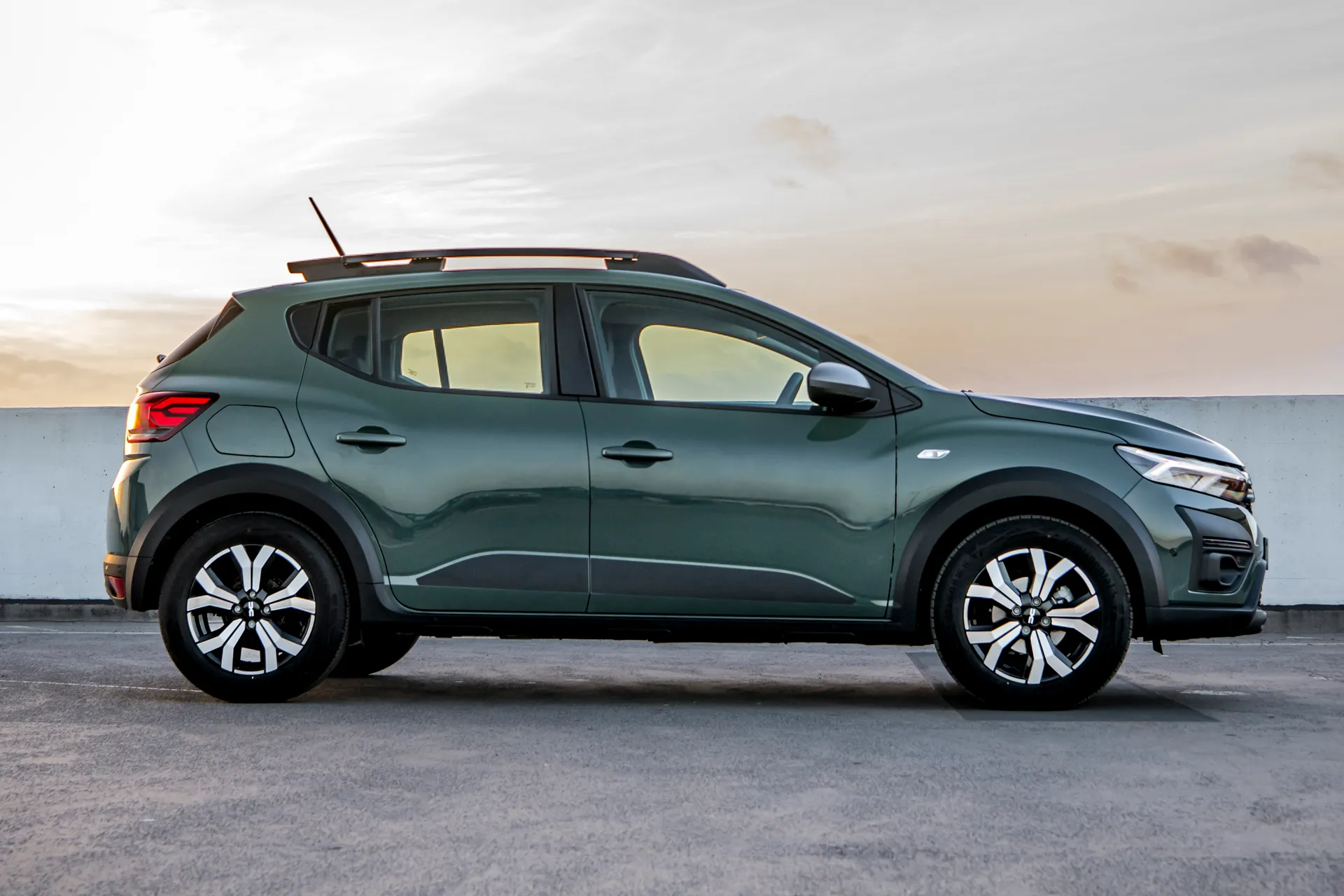
You'll pay a small price for buying the Stepway model over the regular Dacia Sandero in terms of fuel economy. Officially the TCe 90 model manages 51.4mpg combined instead of the 54mpg the regular Sandero manages, although in the real world we found mid fourties MPG was easily achievable. It's worth noting that the CVT automatic version is about 5mpg less efficient on paper.
If you opt for the TCe 100 Bi-Fuel model you'll get 49.6mpg on petrol, dropping to 40.4mpg when using cheaper LPG. Again, that's slightly less than the non-Stepway Sandero. Neither version is exceptionally efficient in the context of small cars, however.
How reliable is a Dacia Sandero Stepway?
You might think that a budget model like the Dacia Sandero Stepway will represent compromises in terms of build quality and reliability. Sure, it doesn't feel luxurious in any way, but most of the car feels sturdy and like it should last reasonably well. Most of the mechanical bits are shared with the Renault Clio, and so far we've not heard of any big issues.
Dacia actually managed to top the 2021 HonestJohn.co.uk Satisfaction Index, so owners clearly love their cars and feel the brand experience exceeds the budget underpinnings. The brand slipped into second place in the most recent study, but it still beat 27 other manufacturers, all of which charge a lot more for their cars, which is mighty impressive. Also impressive is the fact that Dacia was named as the fifth most reliable carmaker in the survey, and was the only brand in the top 10 not to hail from Japan or Korea.
Insurance groups and costs
The Dacia Sandero Stepway shouldn't really be any more expensive to insure than the regular model. Insurance groups start at group 10 for base versions, rising to 17 in the highest spec trim with the most powerful engine. An experienced driver won't have much of a bill, then, and the Sandero should work for new drivers, too.
VED car tax: What is the annual road tax on a Dacia Sandero Stepway?
The Dacia Sandero Stepway commands the same flat rate of tax as all other petrol and diesel cars, a flat rate that currently sets you back £190 per year. The one exception is the dual-fuel LPG model, which qualifies for a discount, although that discount amounts to the princely sum of a tenner. You can be safe in the knowledge that your Stepway won't be hit with the luxury car VED surcharge for cars that cost over £40,000 when brand new, including options. Even if you choose the most expensive example and add every available optional extra to it (the only ones available being metallic paint and a spare wheel), you won't spend even half that total.
How much should you be paying for a Dacia Sandero Stepway?
"Sadly the days of brand new sub-£10,000 Dacia Sandero Stepways are gone because the brand has killed off its entry-level variants."
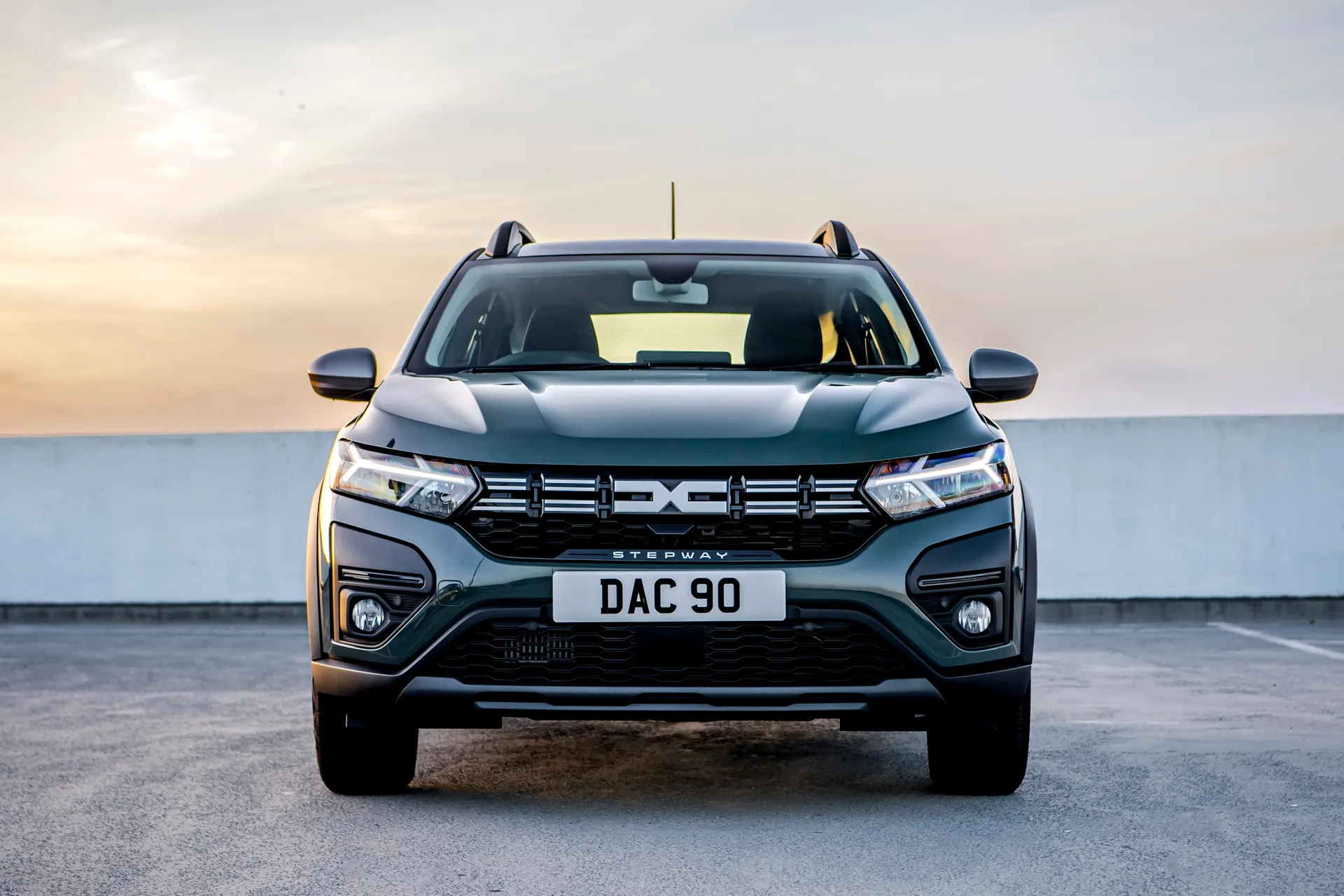
When this generation of Dacia Sandero was launched, it drew headlines for its incredibly low £7,995 starting price, and the Stepway cost about a thousand pounds more. However, a mix of inflation and Dacia removing the base-level engine and trim options has pushed the base price way up.
The cheapest Dacia Sandero Stepway is now more than £15,000 when bought brand new. While that's eye-watering compared to a couple of years ago, it's still cheap in the context of new cars. Only a handful of models can be had for this kind of money or less, and many of those are teeny city cars.
It's worth noting, though, that the Sandero Stepway is around £1,200 more than the equivalent regular Sandero. That might not sound like much, but when you consider it's about 10% of the list price, you have to question if it's really worth it.
Used Dacia Sandero Stepways hold their value exceptionally well, too. You'll still be paying around £9,500 for an early Mk2 example with around 50,000 miles on the clock, while if you want a newer year-old example, that'll be around £13,500, and it'll be a low-spec car with around 20,000 miles on it.
Trim levels and standard equipment
Dacia has changed the trim level names of the Sandero Stepway, but the same equipment levels still apply.
Dacia never bothered offering the austerity-spec Access trim on the Sandero Stepway, which on the regular Sandero didn't come with air-conditioning or even a stereo. Small wonder, then, that fewer than 1% of buyers bothered.
The entry-level Dacia Sandero Stepway Essential comes with alloy wheels, a DAB radio, Bluetooth, cruise control and a speed limiter, automatic emergency braking, a height-adjustable front seat, electric front windows, manual air-con, LED headlamps and tinted windows.
Stepping up to the Dacia Sandero Stepway Expression (formerly Comfort) adds front fog lights, modular roof bars (these were later made standard across the range), electrically adjustable and heated mirrors, keyless entry, automatic lights and wipers, one-touch electric front windows and electric rear windows, rear parking sensors, a touchscreen infotainment system and a rear-view camera.
The top-spec Dacia Sandero Stepway Extreme (formerly Journey) adds to that with sat-nav, an electronic parking brake, front parking sensors, blind spot warning, heated seats, a centre armrest, a leather steering wheel, and climate control.
Ask the heycar experts: common questions
What's the difference between the Dacia Sandero and Sandero Stepway?
Is the Dacia Sandero Stepway reliable?
Which is bigger, the Sandero or the Sandero Stepway?
Get our latest advice, news and offers
Keep me updated by email with the latest advice, news and offers from heycar.
By submitting you agree to our privacy policy
